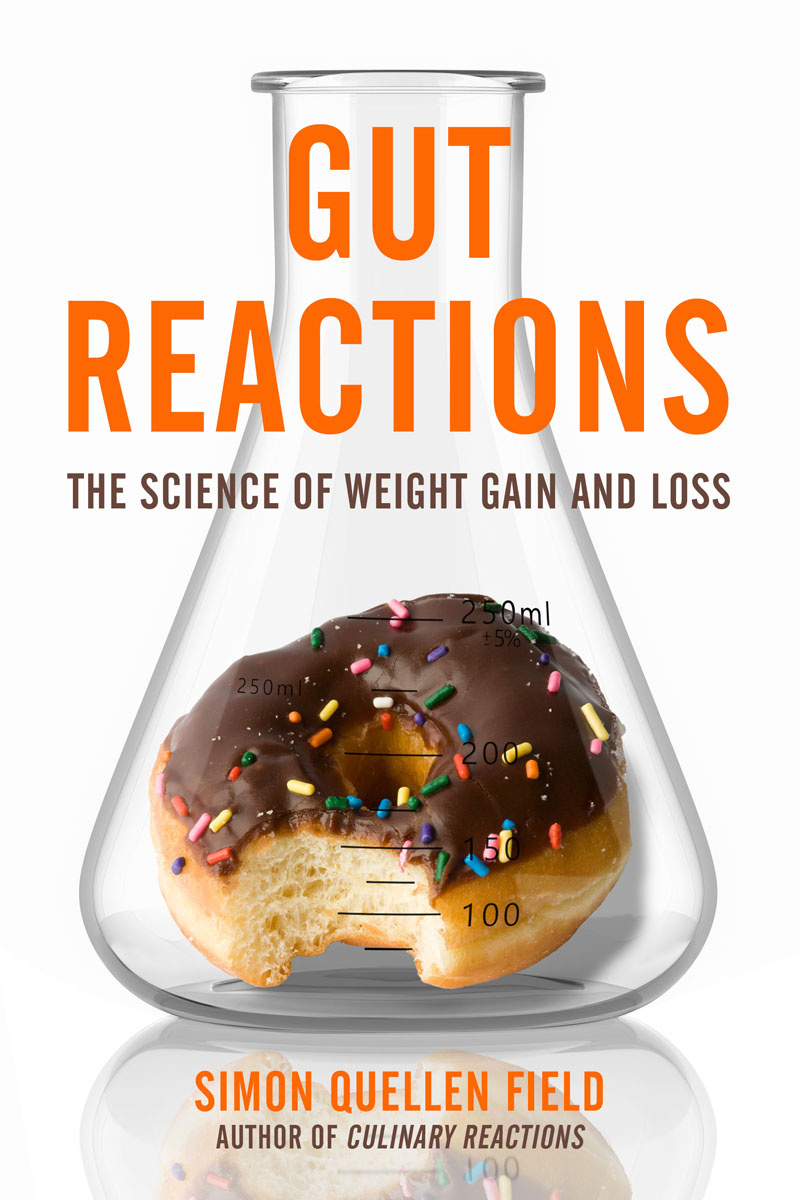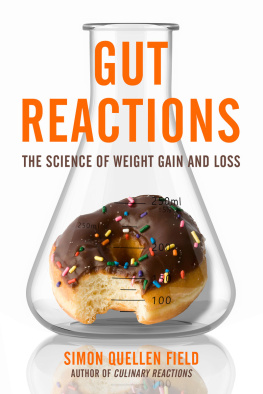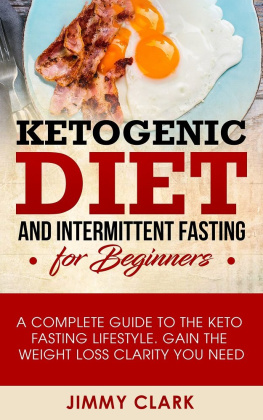Simon Quellen Field - Gut Reactions: The Science of Weight Gain and Loss
Here you can read online Simon Quellen Field - Gut Reactions: The Science of Weight Gain and Loss full text of the book (entire story) in english for free. Download pdf and epub, get meaning, cover and reviews about this ebook. year: 2019, publisher: Chicago Review Press, genre: Romance novel. Description of the work, (preface) as well as reviews are available. Best literature library LitArk.com created for fans of good reading and offers a wide selection of genres:
Romance novel
Science fiction
Adventure
Detective
Science
History
Home and family
Prose
Art
Politics
Computer
Non-fiction
Religion
Business
Children
Humor
Choose a favorite category and find really read worthwhile books. Enjoy immersion in the world of imagination, feel the emotions of the characters or learn something new for yourself, make an fascinating discovery.
- Book:Gut Reactions: The Science of Weight Gain and Loss
- Author:
- Publisher:Chicago Review Press
- Genre:
- Year:2019
- Rating:5 / 5
- Favourites:Add to favourites
- Your mark:
- 100
- 1
- 2
- 3
- 4
- 5
Gut Reactions: The Science of Weight Gain and Loss: summary, description and annotation
We offer to read an annotation, description, summary or preface (depends on what the author of the book "Gut Reactions: The Science of Weight Gain and Loss" wrote himself). If you haven't found the necessary information about the book — write in the comments, we will try to find it.
Gut Reactions: The Science of Weight Gain and Loss — read online for free the complete book (whole text) full work
Below is the text of the book, divided by pages. System saving the place of the last page read, allows you to conveniently read the book "Gut Reactions: The Science of Weight Gain and Loss" online for free, without having to search again every time where you left off. Put a bookmark, and you can go to the page where you finished reading at any time.
Font size:
Interval:
Bookmark:

Copyright 2019 by Simon Quellen Field
All rights reserved
Published by Chicago Review Press Incorporated
814 North Franklin Street
Chicago, Illinois 60610
ISBN 978-1-64160-000-2
Library of Congress Cataloging-in-Publication Data
Names: Field, Simon (Simon Quellen), author.
Title: Gut reactions : the science of weight gain and loss / Simon Quellen Field.
Description: Chicago, Illinois : Chicago Review Press Incorporated, [2019] | Includes bibliographical references and index.
Identifiers: LCCN 2018039859 (print) | LCCN 2018050143 (ebook) | ISBN 9781641600019 (PDF edition) | ISBN 9781641600033 (EPUB edition) | ISBN 9781641600026 (Kindle edition) | ISBN 9781641600002 | ISBN 9781641600002 (trade paperback edition)
Subjects: LCSH: Weight gain. | Weight loss.
Classification: LCC RM222 (ebook) | LCC RM222 .F49 2019 (print) | DDC 613.2/5dc23
LC record available at https://lccn.loc.gov/2018039859
Cover design: John Yates at Stealworks
Cover images: (donut) Ragnar Schmuck/Getty Images; (beaker) urfinguss/iStock Interior design: Jonathan Hahn
Printed in the United States of America
5 4 3 2 1

W alk past the diet section in a bookstore and you will find hundreds of books that each claim to have the solution to weight problems. Whether its a low-fat diet, a low-carbohydrate diet, a Paleolithic diet, a gluten-free diet, or any number of other magical things to try, they all claim that your problem is simple and has a simple solution.
The popularity of these diets is linked to the observation that they all seem to work. Why would these different approaches to weight control all have success? One reason is that they all limit your choices. When you are not able to eat everything in sight, you tend to eat less. Another reason is that each diet targets a different set of people and works for that set, if not for others.
Of course, they all work until they dont. Limiting your diet in this way is difficult to do for long periods of time.
There arent many things that we expect to work for all people all the time. People are different from one another. There are genetic differences, cultural differences, behavioral differences, psychological differences, and social differences, and they all play a part in the weight maintenance equation. Add to these differences age, gender, gut microbiology, and environment and it becomes clear that weight control is a personal thing, and the solutions might have to change not only with each individual, but also with time and setting.
Obesity is not one disease. There are many subtypes of obesity. Some people will have disorders in how their bodies manage energy balance, while others may have differences in how they respond to reward, making it hard for them to resist highly palatable foods. There are many ways to affect our body composition toward more fat, and that is what this book is about.
Homeostasis is the word used for the bodys automatic system for weight control. Homeostasis means staying the same (from the Greek words for similar and standing still). It is very important for the survival of any organism. Without it, the animal starves to death, or feeds to death. Biological systems that are this important have many components, with several checks and balances, and interactions with other systems. Things get complicated.
There are two kinds of weight problems that are related to homeostasis.
Some people slowly gain weight all their life. A weight gain of a single pound a year adds up over time, and by age 40 or 50, those 20 to 30 pounds of extra weight are noticeable in the mirror, on the scale, and in the doctors office.
Other people find that they reach a particular weight and stay there, in homeostasis, but at a weight that is unhealthy or otherwise undesired.
In the first case, homeostasis isnt working properly. In the second case, the controls are set higher than wed like, and we want to change them.
We keep many of our body systems in homeostasis. We regulate our temperaturewe can die if we get too hot or too cold. We regulate our blood pressure and our blood sugar. Again, we can die if either gets too high or too low. Problems with blood sugar homeostasis cause diabetes. It turns out that all these other control systems interact with the control systems for body fat. Disease and fat can be correlated. Obesity is a risk factor for diabetes, and raising the body temperature during a fever burns fat.
As I write this, over 68 percent of adult Americans are overweight, and over 35 percent are obese. We know this isnt just a little bit of weight gain over many years because 32 percent of children and teenagers are overweight, and 17 percent are obese. They havent had time to accumulate their fat slowly. But since obesity rates do go up with age, some part of the problem is small increases over time.
If these numbers had always been the same, we wouldnt worry. We dont worry about obese elephant seals or hippos. Their fat percentages are normal for their species and are essential for their survival. But humans have been gaining weight since the 1960s. While the percentage of people who are overweight but not obese has remained fairly stable, the percentage of obese people has risen from about 13 percent in the 1960s to over 35 percent today (Ogden and Carroll 2010).

Something happened between 1980 and now. The sharp corners in the graph above are an artifact caused by the fact that the data comes from surveys done at particular times. Nonetheless, the overall trend is real. What changed in those years that caused the rise? What has caused the rates to stabilize since 2010? We will look into those questions in the following pages.
The fact that obesity rates changed in the late 1970s, and then stabilized in the 2000s, is actually good news. It means that obesity rates can change. What was done can be undone. In fact, the recent stabilization in growth is likely due to new scientific knowledge about fat homeostasis, and as we make that information more widely available, there is hope that obesity rates may fall as quickly as they rose.
In preindustrial America (before 1900), the obesity rate hovered around 4 percent, compared to 35 percent today.
Some of the changes in the American diet since that time are related to the diversity of the foods available and the ease of preparing food. Before supermarkets, kitchen stoves, refrigerators, restaurants, fast food, and frozen dinners, the variety of foods available was limited. Limiting choice in food is a form of dieting. Food becomes less interesting, and we eat when we are hungry, rather than when we are tempted.
Another change in diet was the rise in consumption of polyunsaturated seed oils, rich in omega-6 fatty acids. We are eating three times the amount of polyunsaturated oil as we were before 1900. Also striking is our doubling of sugar consumption in that period. Consumption of sweetened beverages is five times what it was in 1900.
Our food technology has also allowed manufacturers to improve the palatability of our food, at the same time they improve the appearance, shelf life, and manufacturing efficiencies. Since 1970, Americans have increased the amount eaten per day by 425 calories, a full 20 percent, which may be due to a combination of a wide variety of foods available, the high palatability of those foods, the ease of eating them at a restaurant or out of the microwave, and other factors we have not (yet) discussed.
Next pageFont size:
Interval:
Bookmark:
Similar books «Gut Reactions: The Science of Weight Gain and Loss»
Look at similar books to Gut Reactions: The Science of Weight Gain and Loss. We have selected literature similar in name and meaning in the hope of providing readers with more options to find new, interesting, not yet read works.
Discussion, reviews of the book Gut Reactions: The Science of Weight Gain and Loss and just readers' own opinions. Leave your comments, write what you think about the work, its meaning or the main characters. Specify what exactly you liked and what you didn't like, and why you think so.










